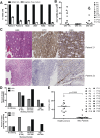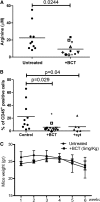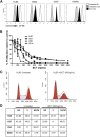Arginine dependence of acute myeloid leukemia blast proliferation: a novel therapeutic target
- PMID: 25710880
- PMCID: PMC4416943
- DOI: 10.1182/blood-2014-09-600643
Arginine dependence of acute myeloid leukemia blast proliferation: a novel therapeutic target
Abstract
Acute myeloid leukemia (AML) is one of the most common acute leukemias in adults and children, yet significant numbers of patients relapse and die of disease. In this study, we identify the dependence of AML blasts on arginine for proliferation. We show that AML blasts constitutively express the arginine transporters CAT-1 and CAT-2B, and that the majority of newly diagnosed patients' blasts have deficiencies in the arginine-recycling pathway enzymes argininosuccinate synthase and ornithine transcarbamylase, making them arginine auxotrophic. BCT-100, a pegylated human recombinant arginase, leads to a rapid depletion in extracellular and intracellular arginine concentrations, resulting in arrest of AML blast proliferation and a reduction in AML engraftment in vivo. BCT-100 as a single agent causes significant death of AML blasts from adults and children, and acts synergistically in combination with cytarabine. Using RNA sequencing, 20 further candidate genes which correlated with resistance have been identified. Thus, AML blasts are dependent on arginine for survival and proliferation, as well as depletion of arginine with BCT-100 of clinical value in the treatment of AML.
© 2015 by The American Society of Hematology.
Figures






References
-
- Marcucci G, Haferlach T, Dohner H. Molecular genetics of adult acute myeloid leukemia: prognostic and therapeutic implications. J Clin Oncol. 2011;29(5):475–486. - PubMed
-
- Gibson BE, Wheatley K, Hann IM, et al. Treatment strategy and long-term results in paediatric patients treated in consecutive UK AML trials. Leukemia. 2005;19(12):2130–2138. - PubMed
Publication types
MeSH terms
Substances
Grants and funding
LinkOut - more resources
Full Text Sources
Other Literature Sources
Medical
Research Materials
Miscellaneous

